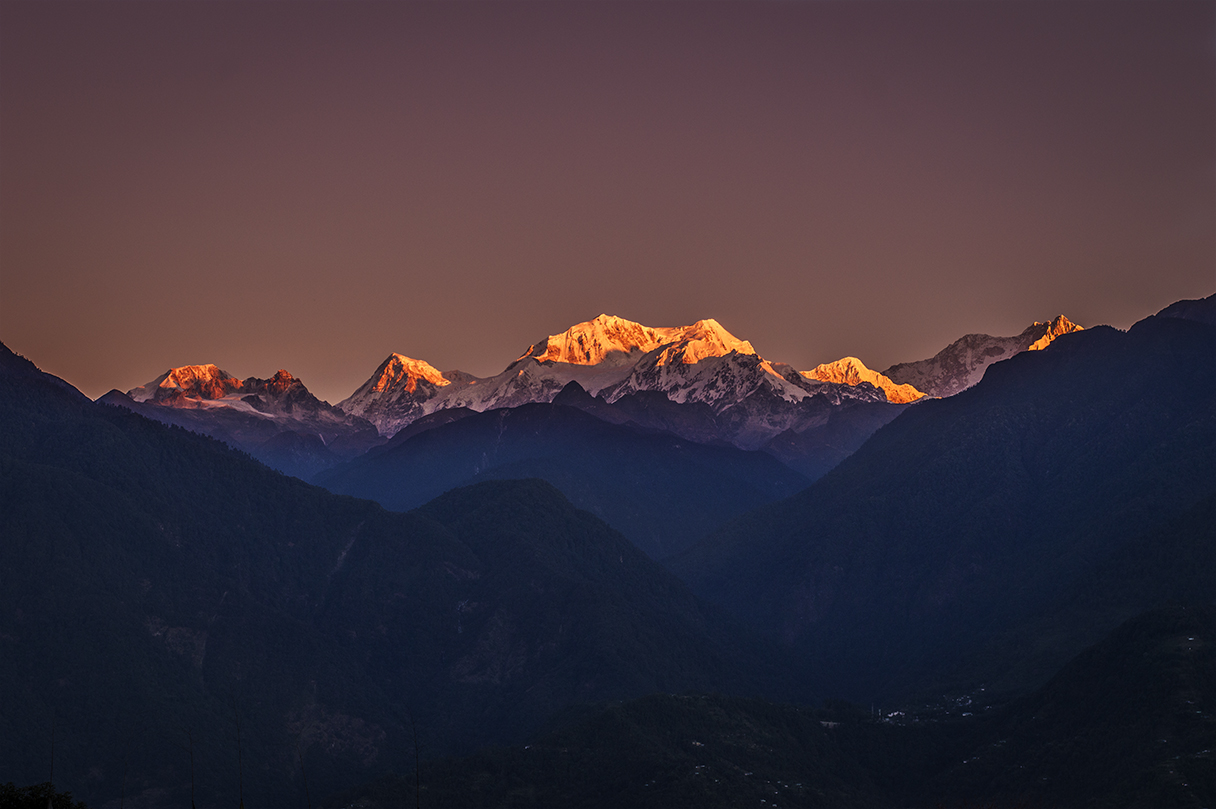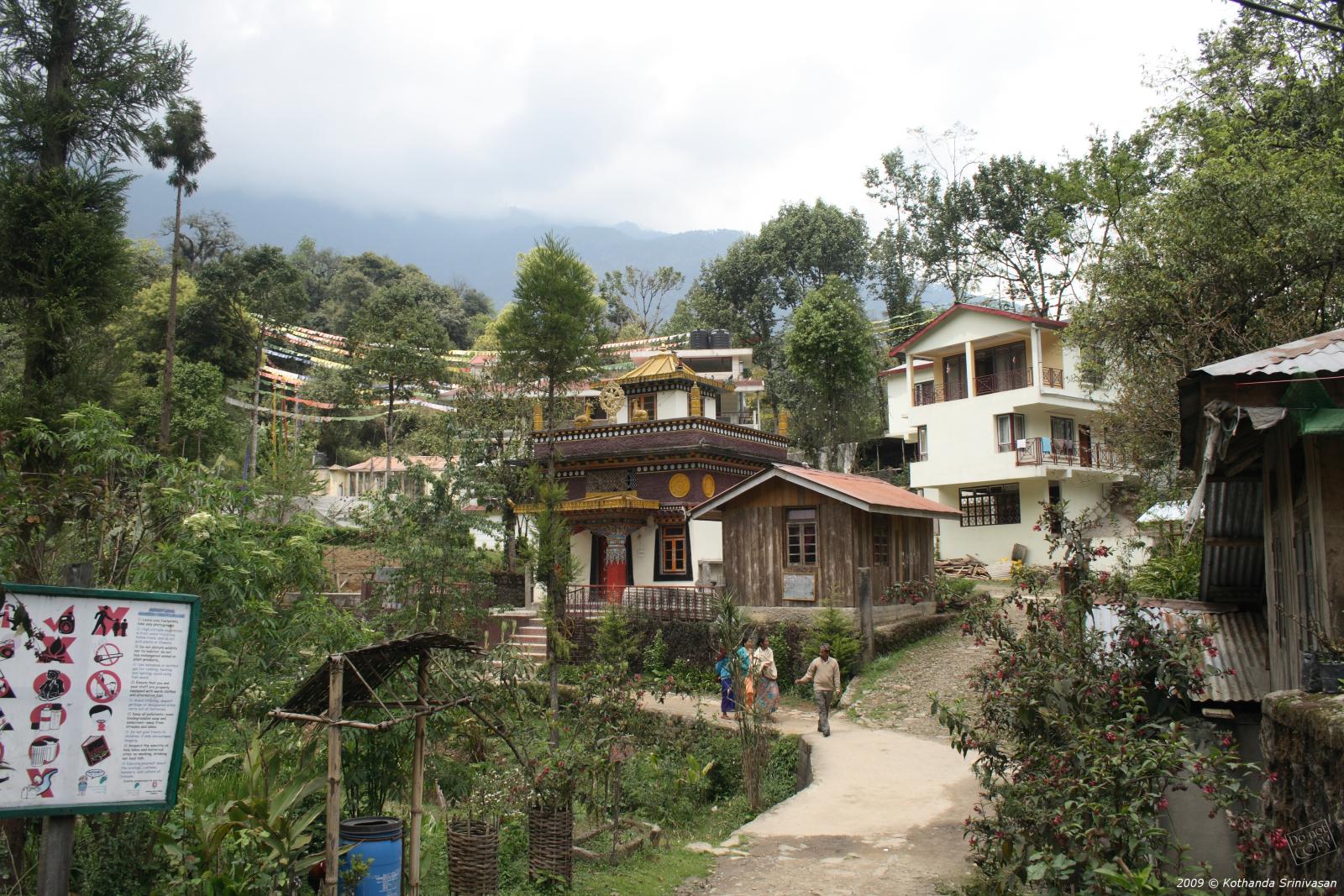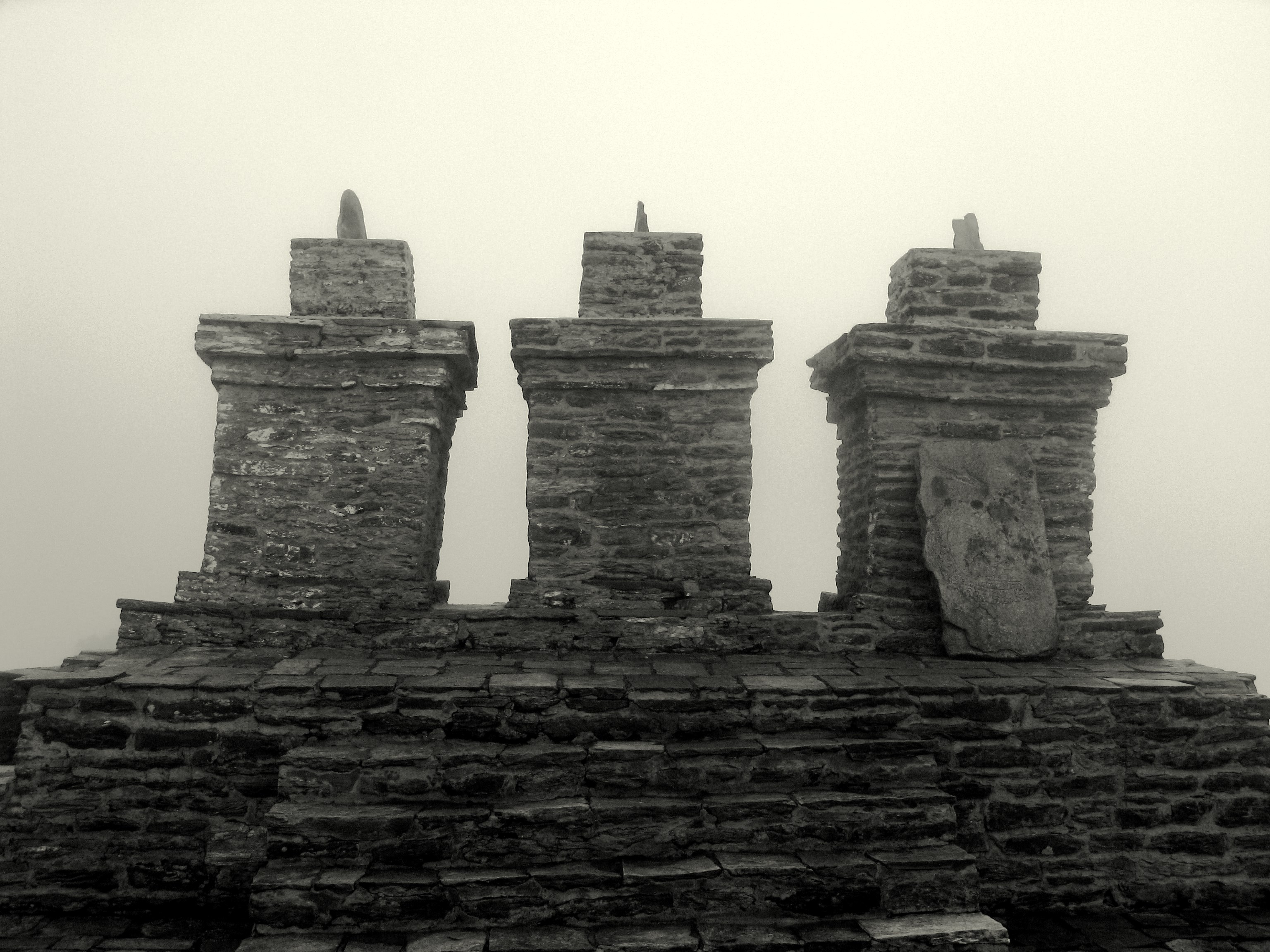|
Norbugang Chorten
The Norbugang Chorten is a stupa situated in the Geyzing subdivision of West Sikkim district in the Indian State of Sikkim. It was erected following the crowning of the first Chogyal of Sikkim in 1642 at Narbugong Coronation Throne near Yuksom. A holy lake known as Kuthok Lake, a serene lake, is also linked to the historicity of the place. The Chorten was the place where Lama Lhutsun Chempo created the time capsule by burying all the gifts to mark the occasion. The Norbugang Chorten and the Norbugang throne are visited as part of Buddhist religious pilgrimage circuit involving the Dubdi Monastery, Pemayangtse Monastery, the Rabdentse ruins, the Sanga Choeling Monastery, the Khecheopalri Lake, and the Tashiding Monastery. History Norbugang Chorten was established during a consecration ceremony that was held by three learned Lamas headed by Lhatsun Chempo, crowning the first Chogyal of Sikkim. Lhatsun Chempo had suffixed his own surname of 'Namgye' to Phunshog who was crowned th ... [...More Info...] [...Related Items...] OR: [Wikipedia] [Google] [Baidu] |
Yuksom
Yuksom is a historical town in Geyzing subdivision of West Sikkim district in the Northeast Indian state of Sikkim. It was the first capital of Kingdom of Sikkim established in 1642 AD by Phuntsog Namgyal who was the first Chogyal (temporal and religious king) of Sikkim. The coronation site of the first monarch of Sikkim is known as the "Throne of Norbugang". Yuksom is where there is the Norbugang Chorten near the Norbugang throne, the place Namgyal was crowned and several monasteries and a lake. The dynastic rule of the Chogyals lasted for 333 years. The Chogyal established the first monastery at Yuksom in Sikkim known as the Dubdi Monastery in 1701, which is part of Buddhist religious pilgrimage circuit involving the Norbugang Chorten, Pemayangtse Monastery, the Rabdentse ruins, the Sanga Choeling Monastery, the Khecheopalri Lake, and the Tashiding Monastery. For the Bhutia community of Sikkim, Yuksom has special religious and cultural significance. It has a number of famous B ... [...More Info...] [...Related Items...] OR: [Wikipedia] [Google] [Baidu] |
Sanga Choeling Monastery
The Sanga Choeling Monastery, also spelt Sange Choeling Monastery (, THL ''Sangngak Chö Ling''), established in the 17th century by Lama Lhatsün Chempo, is one of the oldest monasteries in the Northeast Indian state of Sikkim. The literal meaning of Sanga Choeling is "Island of the Guhyamantra teachings", where ''gling'' means a vihara and "secret Mantra teachings" is a synonym for "Vajrayana Buddhism". The monastery is located on a ridge top above Pelling at a distance of from Pemayangtse Monastery and is accessed by walking the steep hilly track of , which traverses through rich forest cover. Pilgrimage to Sanga Choeling Monastery is undertaken by many Buddhist devotees as part of a religious and heritage circuit encompassing Pemayangtse Monastery, Rabdentse ruins, Khecheopalri Lake, Norbugang Chorten, Dubdi Monastery, Yuksom and Tashiding Monastery. Architecture Sanga Choeling Monastery, built in 1697, is also known as the place of secret spells. It has clay statues d ... [...More Info...] [...Related Items...] OR: [Wikipedia] [Google] [Baidu] |
Pine
A pine is any conifer tree or shrub in the genus ''Pinus'' () of the family Pinaceae. ''Pinus'' is the sole genus in the subfamily Pinoideae. The World Flora Online created by the Royal Botanic Gardens, Kew and Missouri Botanical Garden accepts 187 species names of pines as current, together with more synonyms. The American Conifer Society (ACS) and the Royal Horticultural Society accept 121 species. Pines are commonly found in the Northern Hemisphere. ''Pine'' may also refer to the lumber derived from pine trees; it is one of the more extensively used types of lumber. The pine family is the largest conifer family and there are currently 818 named cultivars (or trinomials) recognized by the ACS. Description Pine trees are evergreen, coniferous resinous trees (or, rarely, shrubs) growing tall, with the majority of species reaching tall. The smallest are Siberian dwarf pine and Potosi pinyon, and the tallest is an tall ponderosa pine located in southern Oregon's Rogue Riv ... [...More Info...] [...Related Items...] OR: [Wikipedia] [Google] [Baidu] |
Cryptomeria
''Cryptomeria'' (literally "hidden parts") is a monotypic genus of conifer in the cypress family Cupressaceae, formerly belonging to the family Taxodiaceae. It includes only one species, ''Cryptomeria japonica'' ( syn. ''Cupressus japonica'' L.f.). It used to be considered by some to be endemic to Japan (see remark below under 'Endemism'), where it is known as . The tree is called Japanese cedar or Japanese redwood in English. It has been extensively introduced and cultivated for wood production on the Azores. Description ''Cryptomeria'' is a very large evergreen tree, reaching up to tall and trunk diameter, with red-brown bark which peels in vertical strips. The leaves are arranged spirally, needle-like, long; and the seed cones globular, diameter with about 20–40 scales. It is superficially similar to the related giant sequoia (''Sequoiadendron giganteum''), from which it can be differentiated by the longer leaves (under in the giant sequoia) and smaller cones ( in ... [...More Info...] [...Related Items...] OR: [Wikipedia] [Google] [Baidu] |
Stupa
A stupa ( sa, स्तूप, lit=heap, ) is a mound-like or hemispherical structure containing relics (such as ''śarīra'' – typically the remains of Buddhist monks or nuns) that is used as a place of meditation. In Buddhism, circumambulation or ''pradakhshina'' has been an important ritual and devotional practice since the earliest times, and stupas always have a ''pradakhshina'' path around them. The original South Asian form is a large solid dome above a tholobate or drum with vertical sides, which usually sits on a square base. There is no access to the inside of the structure. In large stupas there may be walkways for circumambulation on top of the base as well as on the ground below it. Large stupas have or had ''vedikā'' railings outside the path around the base, often highly decorated with sculpture, especially at the torana gateways, of which there are usually four. At the top of the dome is a thin vertical element, with one of more horizontal discs spreadin ... [...More Info...] [...Related Items...] OR: [Wikipedia] [Google] [Baidu] |
Pelling
Pelling is a small hill town in the district of West Sikkim, India. Pelling is nestled at an altitude of 2,150 m (7,200 feet). The town is located at a distance of 10 km from the district headquarters of Geyzing and 131 km from Gangtok. A regular bus service connects the two towns. However, with the influx of tourists, the region is undergoing a metamorphosis, with the roads being repaired and hotels being set up. Location and surroundings The Himalayas and the Kanchenjanga may be viewed at close quarters from Pelling. Pelling also forms the base from where trekkers and other peripatetic adventurers undertake the strenuous and arduous treks in West Sikkim. The land around Pelling is still a virgin territory and is bathed with alpine vegetation, with numerous waterfalls lining the hillside. In the months of winter, Pelling is sometimes covered with a blanket of snow. Pelling is 115 km from the state capital Gangtok and about 135 km from Siligur ... [...More Info...] [...Related Items...] OR: [Wikipedia] [Google] [Baidu] |
Magar People
The Magar, also spelled as Mangar, and Mongar, are the third largest ethnolinguistic groups of Nepal, indigenous to Western Nepal and representing 7.1% of Nepal's total population according to the 2011 Nepal census. The original home of the Magar people was to the west of Gandaki river, and roughly speaking, consisted of that portion of Nepal which lies between and around about Gulmi, Arghakhanchi, and Palpa. This part of the country was divided into twelve districts known as "''Bahra Magarat''" (Confederation of Twelve Magar Kingdoms), which included the following regions of that period: Argha, Khanchi, Bhirkot, Dhor, Garhung, Ghiring, Gulmi, Isma, Musikot, Pyung, Rising, Satung, and Pyung. During the medieval period, the whole area from Palpa to Rukum Rolpa was called the "Magarat"'','' a place settled and inhabited by Magars. Another Confederation of Eighteen Magar Kingdoms known as "''Athara Magarat''" also existed, and was originally inhabited by Kham Magars. Origin There ... [...More Info...] [...Related Items...] OR: [Wikipedia] [Google] [Baidu] |
Lepcha People
The Lepcha (; also called Rongkup ( Lepcha: , ''Mútuncí Róngkup Rumkup'', "beloved children of the Róng and of God") and Rongpa ( Sikkimese: )) are among the indigenous peoples of the Indian state of Sikkim and Nepal, and number around 80,000. Many Lepcha are also found in western and southwestern Bhutan, Tibet, Darjeeling, the Province No. 1 of eastern Nepal, and in the hills of West Bengal. The Lepcha people are composed of four main distinct communities: the Renjóngmú of Sikkim; the Dámsángmú of Kalimpong, Kurseong, and Mirik; the ʔilámmú of Ilam District, Nepal; and the Promú of Samtse and Chukha in southwestern Bhutan. Origins The word Lepcha is considered to be the anglicised version of the Nepalese word ''lepche'' meaning "vile speakers" or "inarticulate speech". This was at first a derogatory nickname but is no longer seen as negative. The origin of the Lepcha is unknown. They may have originated in Myanmar or Tibet but the Lepcha people themselves fir ... [...More Info...] [...Related Items...] OR: [Wikipedia] [Google] [Baidu] |
Tashiding Monastery
Tashiding Monastery is a Buddhist monastery of the Nyingma sect of Tibetan Buddhism in Western Sikkim, northeastern India, which is the most sacred and holiest monasteries in Sikkim. It is described as the "Heart of Sikkim/Denzong", citing to its importance of religious sacredness. It is located on top of the hill rising between the Rathong chu and the Rangeet River, from Gyalshing and to the south east of Yuksam. The annual festival of Bumchu, meaning ~Holy water~ takes place on the 14th and 15th of the 1st month of Tibetan lunar calendar, often around the months of February and March. The festival is believed to predict the upcoming forecasts and events for Sikkim in the coming year. Undoubtedly, one of the most important and holiest festivals for all the Buddhists in Sikkim and around, it also provides for a perfect platform for all those Non-Buddhists who seek a deeper insight into Buddhism and its religious customs, beliefs and rituals. History of the Festival- Somewhere ... [...More Info...] [...Related Items...] OR: [Wikipedia] [Google] [Baidu] |
Khecheopalri Lake
Khecheopalri Lake, originally known as Kha-Chot-Palri (meaning the heaven of Padmasambhava), is a lake located near Khecheopalri village, west of Gangtok in the West Sikkim district of the Northeastern Indian state of Sikkim. Located to the northwest of Pelling town, the lake is sacred for both Buddhists and Hindus, and is believed to be a wish fulfilling lake. The local name for the lake is ''Sho Dzo Sho'', which means "Oh Lady, Sit Here". The popularly known name of the lake, considering its location is Khecheopalri Lake, ensconced in the midst of the Khechoedpaldri hill, which is also considered a sacred hill. The lake is an integral part of the much revered valley of "Demazong" meaning valley of rice. This landscape is also known as a land of hidden treasures blessed by Guru Padmasambhava. The Khecheopalri Lake is also part of Buddhist religious pilgrimage circuit involving the Yuksom, the Dubdi Monastery in Yuksom, Pemayangtse Monastery, the Rabdentse ruins, the Sanga ... [...More Info...] [...Related Items...] OR: [Wikipedia] [Google] [Baidu] |
Rabdentse
Rabdentse was the second capital of the former Kingdom of Sikkim from 1670 to 1814. The capital city was destroyed by the invading Gurkha army and only the ruins of the palace and the chortens are seen here now. However, the ruins of this city are seen close to Pelling and in West Sikkim district in the Northeastern Indian state of present-day Sikkim; Pemayangtse Monastery is one of the oldest monasteries in Sikkim which is close to the ruins. From the vantage point of this former capital, superb views of the Khanchendzonga ranges can be witnessed. This monument has been declared as of national importance by the Archaeological Survey of India. It was first established in 1670 by the 2nd Chogyal Tensung Namgyal son of the 1st Chogyal Phuntsog Namgyal by shifting from the first capital of Yuksom that was consecrated in 1642. The Rabdentse ruins are part of Buddhist religious pilgrimage circuit starting with the first monastery at Yuksom known as the Dubdi Monastery, followed by No ... [...More Info...] [...Related Items...] OR: [Wikipedia] [Google] [Baidu] |
Sikkim
Sikkim (; ) is a state in Northeastern India. It borders the Tibet Autonomous Region of China in the north and northeast, Bhutan in the east, Province No. 1 of Nepal in the west and West Bengal in the south. Sikkim is also close to the Siliguri Corridor, which borders Bangladesh. Sikkim is the least populous and second smallest among the Indian states. Situated in the Eastern Himalaya, Sikkim is notable for its biodiversity, including alpine and subtropical climates, as well as being a host to Kangchenjunga, the highest peak in India and third highest on Earth. Sikkim's capital and largest city is Gangtok. Almost 35% of the state is covered by Khangchendzonga National Park – a UNESCO World Heritage Site. The Kingdom of Sikkim was founded by the Namgyal dynasty in the 17th century. It was ruled by Buddhist priest-kings known as the Chogyal. It became a princely state of British India in 1890. Following Indian independence, Sikkim continued its protectorate status with ... [...More Info...] [...Related Items...] OR: [Wikipedia] [Google] [Baidu] |








